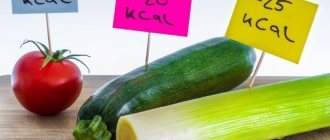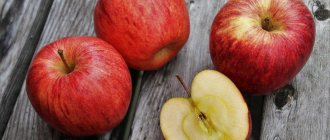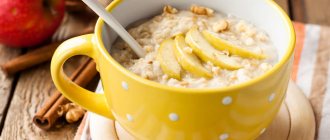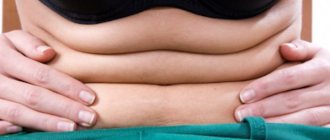Low-calorie diets that contain buckwheat porridge are now in fashion not only because of girls trying to lose weight, but also because the number of people with diabetes mellitus (DM) has increased. Every year there are only more and more diabetics, but a cure for this disease has not yet been created.
The main problem of people with diabetes is the lack or poor perception of insulin produced by the pancreas, which is responsible for transporting glucose from the blood to the body's cells.
Due to the fact that there is not enough hormone, the concentration of sugar increases and the person’s blood vessels begin to collapse.
At the same time, creating a new menu to normalize sugar levels is not so simple, because you need to know not only the number of calories in a certain product, but also its glycemic index (GI). This indicator is responsible for the degree of digestion of food and has a scale from 0 to 100, where 100 is the GI of glucose.
How to cook porridge
Even if you take cereal that is super healthy for you, it still needs to be cooked correctly. But don't worry, the rules are easy and probably familiar to you.
- Cook the porridge in water. If you want to make it richer, add milk at the very end. And milk should not be fatty. Don't forget to ask your doctor to be sure. From time to time it is allowed to cook porridge only with milk, for example, once every 2 weeks.
- Sweets should not be added to porridge. But you already know this for sure. You can add nuts, herbs, chopped vegetables, for example, the same buckwheat can be made with pieces of carrots and onions.
- For dressing, use vegetable oil, not butter. This will reduce the calorie content of the finished product.
- The best method of preparation is brewing. You can boil it, but brewing it will ensure the preservation of vitamins. The preparation method is simple - pour boiling water over the cereal and leave overnight. In the morning, breakfast is already ready.
Now you know what cereals you can eat if you have type 2 diabetes. As you can see, everything is not so bad, you just need to understand the details and not let the manufacturers confuse you.
Still have questions? Then we are waiting for you in the comments. Add to bookmarks.
Sources:
- Astamirova H. Great encyclopedia of diabetics
- Nesterova A. Medical nutrition for diabetes mellitus
ul
Glycemic index of cereals and cereals, full table
(96.36%) voted
It's no secret that porridge is healthy. Even with diabetes, when every extra carbohydrate counts. It is cereals that provide the body with up to 50% of the daily value of all useful minerals and vitamins. Therefore, you cannot deny yourself a portion of porridge because of its carbohydrate content.
How to choose cereals according to GI
You need to know the glycemic index of cereals and choose only cereals with a low index.
Loading …
Having looked at the entire range of different cereals, you can easily divide the products into 2 groups - processed and not. Those processed include:
- Steamed and fried cereals
- Instant porridge
- Processed and polished cereals
Processed cereals contain fewer nutrients, more calories, and the glycemic index of such cereals is much higher than their unprocessed counterparts.
For example, buckwheat is a very healthy cereal for diabetes. The GI of classic fried buckwheat is 50, and that of whole green buckwheat is 15.
Below are tables of the glycemic index of cereals. Be careful and choose only those cereals whose GI is less than 55. Read what GI is here.
Table of cereals and porridges
low glycemic index
| Green buckwheat | 15GI |
| Rice bran | 19GI |
| Pearl barley | 22GI |
| Rye grains, sprouted | 34GI |
| Quinoa | 35GI |
| Mamalyga (corn flour porridge) | 40GI |
| Bulgur | 48GI |
| Oatmeal | 49GI |
| Fried buckwheat | 50GI |
| Brown rice | 50GI |
| Bran | 51GI |
| Wild rice | 55GI |
Porridges with a low glycemic index can be eaten every day, observing the counting of bread units. Typically, one serving contains 6-8 tablespoons of cooked cereal.
When calculating, please note that bread units in the tables are usually indicated for raw cereals. To calculate the carbohydrate cost of porridge, you need to enter the weight of the cereal and the amount of water you used for cooking into the nutrition calculator. If you added oil, don't forget to take that into account when calculating.
You can save the finished recipe in your recipes without having to beat in the ingredients again. By changing the portion weight, you will receive the exact number of bread units.
Glycemic index of cereals and cereals, table
high GI
| White rice | 60GI |
| Couscous | 65GI |
| Semolina | 65GI |
| Oatmeal, instant | 66GI |
| Steamed white rice | 70GI |
| Millet | 71GI |
| Muesli with nuts and raisins | 80GI |
| Cornflakes | 85GI |
| Instant rice porridge | 90GI |
High-glycemic cereal products should be excluded from the diabetic diet whenever possible. This especially applies to people with still problematic, uncompensated blood sugar levels.
Another tip is food variety. Each grain has its own special minerals and elements.
To create the most healthy diabetic diet, alternate cereals from the table with a low glycemic index at least every day. At the same time, it is better to consume them in the first half of the day, when our body most needs energy.
ul
Wide variability in the glycemic index of rice and potatoes
What is the GI of rice and potatoes? This question is often asked by both scientists and people far from science. It's not easy to answer.
The fact is that the data on these two simple food products varies so much that it is almost impossible to give an average value.
Thus, the glycemic index of rice can range from 54 to 132, and of potatoes - from 67 to 158.
Why are the GI data for rice and potatoes so different?
Because the content of amylose and amylopectin varies in different varieties. The more amylose, the lower the glycemic index.
There are 4 main varieties of rice:
- long grain;
- medium grain;
- short grain;
- sweet or sticky (commonly used to make sauces in Asian restaurants).
Sweet rice contains no amylose at all. And its GI is maximum. Long-grain varieties, for example, Basmani, have the most amylose, and therefore their GI is minimal.
Additionally, each of these rice varieties can be white or brown. Brown always has a lower GI than white.
So, if we are talking about the popular Basmani rice, then its white form has a glycemic index of 83. The exact GI of brown Basmani has not yet been established, but scientists suggest that it is minimal, that is, about 54.
You can read more about how a grain of rice works and how its consumption affects weight loss in this article.
The situation is similar with potatoes. Different varieties have different amylose to amylopectin ratios, and therefore different GI values.
Moreover, young potatoes always have a lower glycemic index than more mature potatoes of the same variety. This is due to the fact that as the tubers mature, they contain less and less amylose and more and more amylopectin.
Special food
Experts have developed a special porridge “Stop Diabetes” for type 2 diabetes. The following components provide a positive effect from possible use:
- Flax porridge.
- Amaranth leaves.
- A mixture of barley, oatmeal and buckwheat (incredibly healthy cereals).
- Ground pear.
- Onion.
- Jerusalem artichoke.
These diabetic components were not chosen by chance. They all complement each other, providing a long-term health effect if you eat the dish daily. Flaxseed porridge contains Omega 3, making muscles and tissues more responsive to insulin. The pancreas will function normally with the help of minerals that are present in large quantities.

Diabetes also requires special preparation of this porridge. The recipe is simple: 15-30 g of the contents of the package are poured with 100-150 g of warm milk - it is better to use it rather than water. Stir thoroughly, leave for 10 minutes before the second cooking period to allow the flakes to swell sufficiently.
After the allotted time, add a little of the same warm liquid so that it covers the food. The porridge can be eaten with a sugar substitute or ginger oil; before this, the porridge for diabetics can be slightly salted. There are more useful substances there than in sweets, so they will have to be replaced with something. Helpful advice: also avoid cough drops, they contain sugar. How much and when? Eat this dish daily (you can eat it twice a day in small portions). Read on for detailed recommendations for use.
ul
Blood glucose level and reasons for its increase or decrease

The average fasting blood glucose level in a healthy adult ranges from 3.3 to 5.5 mmol/L. After eating, glucose levels rise sharply for a while and then recover.
There is such a thing as the glycemic index - this is the ability to increase blood glucose levels by foods that contain carbohydrates. If its values increase, this indicates that glucose, which requires insulin for its absorption, accumulates faster and more. If these values are reduced in foods or dishes, then glucose enters the blood more slowly and evenly, and this requires a small amount of insulin.
ul
List of foods with different glycemic index (GI):
- below 15 (all types of cabbage, zucchini, spinach, sorrel, radish, radishes, turnips, cucumber, asparagus, leeks, rhubarb, sweet peppers, mushrooms, eggplants, squash);
- 15–29 (prunes, blueberries, cherries, plums, citrus fruits, lingonberries, cherries, cranberries, tomatoes, pumpkin seeds, nuts, dark chocolate, kefir, fructose);
- 30–39 (black, white, red currants, pear, fresh and dried apples, peaches, raspberries, dried apricots, peas, beans, apricots, milk, milk chocolate, low-fat fruit yogurt, lentils);
- 70–79 (raisins, beets, pineapple, watermelon, rice, boiled potatoes, ice cream, sugar, muesli, cheesecakes);
- 80–89 (baked goods, candies, carrots, caramel);
- 90–99 (white bread, baked and fried potatoes).
Two groups of hormones influence the concentration of glucose in the blood. The hormone that lowers blood glucose levels is insulin; Hormones that increase blood glucose levels are glucagon, growth hormone and glucocorticoids, adrenal hormones. Adrenaline, which is one of the stress hormones, suppresses the release of insulin into the blood. One of the symptoms of diabetes is a prolonged increase in blood glucose (hyperglycemia).
The causes of hyperglycemia can be:
- various stressful situations,
- hereditary factor
- genetic disorders
- allergic reactions,
- long-term colds, etc.
ul
Diet and cooking technology
The diet should be 5-6 meals a day with an interval between meals of 2-3 hours and the last meal 1.5-2 hours before bedtime.
- It is advisable to start breakfast with porridge with the addition of either 1 egg or 2 eggs in the form of an omelet. The volume of porridge is about 250–300 ml. Among the breakfast drinks you can use tea with milk, coffee with milk, cocoa with milk, chicory with milk. If you don’t like adding milk to these drinks, you can combine them with 45% fat hard cheese or cottage cheese.
- For second breakfast, it is recommended to make a fruit-berry-yogurt cocktail, you can add nuts and dried fruits, or use vegetable salads like Greek or Shopska or other similar salads.
- For lunch you should use first courses (red borscht, green soup, chicken soup, various broths, soups, etc.) in a volume of 250-300 ml/day. For the main course, we recommend chicken breast, chicken (remove the skin from the chicken before heat treatment), beef, veal, lean pork (in the form of meatballs, cutlets, brisoles) without adding eggs to the minced meat. Since the protein avidin, found in eggs, blocks the absorption of iron contained in meat, it is not recommended to combine it with vegetables in the same meal. To prepare minced meat, it is recommended to clean the meat from fascia and tendons, grind it twice in a meat grinder with the addition of onion and salt. It is advisable to consume meat components with porridge or whole grain pasta. It is advisable to extend the interval between meat dishes and vegetable dishes to 1–1.5 hours.
- Among the drinks, we recommend dried fruit compotes or rosehip decoction, or fruit and berry jelly, or fresh juice diluted with bottled drinking water.
- For an afternoon snack, you can use cottage cheese and fruit salad or fruit salad, or vegetable salad with a volume of 150 g/day.
- It is recommended to start dinner with fish dishes with the addition of a vegetable side dish. Drinks: tea, cocoa or chicory with milk. At night, you can drink a glass of biokefir or eat yogurt. It is advisable to drink water in the volume calculated according to the formula: 20-30 ml of liquid per kilogram of body weight. A small amendment: in the summer, the figure is 30 ml, in the spring-autumn period - 25 ml, and in the winter - 20 ml. This liquid is consumed taking into account all liquids drunk (drinks and first courses).
The cooking technology is based on the fact that it is advisable to prepare all food products without adding fat. Vegetable fats (olive, corn oil) should be added to food just before serving the dish, since as a result of heating vegetable oil, drying oil and carcinogenic substances are formed, which have a detrimental effect on the walls of blood vessels and provoke not only the development of cardiovascular pathology in humans, but also oncological pathology. Types of cooking: steaming, boiling, stewing, baking.
What to do if you have diabetes?!
We recommend reading an exclusive article on how to forget about diabetes forever... Read more >> |
ul
Table of glycemic load and food index
The complete table of parameters for the most common foods containing carbohydrates is as follows.
| Products | GI | A portion | GN |
| Sweets | |||
| Honey | 87 | 1 tsp | 3 |
| Lollipops | 78 | 28 g | 22 |
| Snickers | 68 | 60 g (half) | 23 |
| Table sugar | 68 | 2 tsp | 7 |
| Strawberry jam | 51 | 2 tsp | 10.1 |
| Dark chocolate | 23 | 35 g | 4.4 |
| Baking and cereals | |||
| French baguette | 95 | 1 piece | 29.5 |
| Donut | 76 | 1 (about 75 g) | 24.3 |
| Waffle (homemade) | 76 | ! (about 75g) | 18.7 |
| Millet | 71 | 150 g | 26 |
| Regular loaf | 70 | 1 piece | 7.7 |
| Corasan | 67 | 1 medium | 17.5 |
| Muesli | 66 | 2/3 cup | 23.8 |
| Oatmeal (quick) | 65 | 1 glass | 13.7 |
| 100% rye bread | 65 | 1 piece | 8.5 |
| Rye bread | 65 | 1 (about 25g) | 11.1 |
| Blueberry muffin | 59 | 1 medium | 30 |
| Regular oatmeal | 58 | 1/2 cup | 6.4 |
| Wheat pita | 57 | one | 17 |
| Oat cookies | 55 | 1 large | 6 |
| Popcorn | 55 | 1 glass | 2.8 |
| Buckwheat | 55 | 150 g | 16 |
| Spaghetti | 53 | 180 g | 23 |
| Potato dumplings | 52 | 150 g | 23 |
| Bulgur | 46 | 150 g | 12 |
| Vanilla sponge cake with vanilla glaze | 42 | 1 piece | 16 |
| Chocolate sponge cake with chocolate icing | 38 | 1 piece | 12.5 |
| Dumplings | 28 | 100 g | 6 |
| Beverages | |||
| Cola | 63 | 330 ml | 25.2 |
| Orange juice | 57 | 1 machine | 14.25 |
| carrot juice | 43 | 1 glass | 10 |
| Cocoa with milk | 51 | 1 glass | 11.7 |
| Grapefruit juice | 48 | 1 glass | 13.4 |
| Pineapple juice | 46 | 1 glass | 14.7 |
| Soy milk | 44 | 1 glass | 4 |
| Apple juice | 41 | 1 glass | 11.9 |
| Tomato juice | 38 | 1 glass | 3.4 |
| Legumes | |||
| Lima beans | 31 | 1 glass | 7.4 |
| Chickpeas | 31 | 1 glass | 13.3 |
| Lentils | 29 | 1 glass | 7 |
| Regular beans | 27 | 1 glass | 7 |
| Soya beans | 20 | 1 glass | 1.4 |
| Peanut | 13 | 1 glass | 1.6 |
| Vegetables | |||
| Carrot | 92 | 1 medium | 1 |
| Beet | 64 | 1 medium | 9.6 |
| Corn | 55 | 1 glass | 61.5 |
| Green pea | 48 | 1/2 cup | 3.4 |
| Tomato | 38 | 1 medium | 1.5 |
| Broccoli | 0 | 1/2 cup (boiled) | 0 |
| Cabbage | 0 | 1/2 cup (boiled) | 0 |
| Celery | 0 | 60 g | 0 |
| Cauliflower | 0 | 100g (1 cup) | 0 |
| Green bean | 0 | 1 glass | 0 |
| Mushrooms | 0 | 70 g | 0 |
| Spinach | 0 | 1 glass | 0 |
| Fruits | |||
| Watermelon | 72 | 1 cup pulp | 7.2 |
| A pineapple | 66 | 1 glass | 11.9 |
| Cantaloupe | 65 | 170 g | 7.8 |
| Canned apricots | 64 | 1 glass | 24.3 |
| Raisin | 64 | 43g | 20.5 |
| Canned peach | 58 | 262g (1 cup) | 28.4 |
| Kiwi | 58 | one | 5.2 |
| Bananas | 51 | 1 medium | 12.2 |
| Mango | 51 | 160 g | 12.8 |
| Orange | 48 | one | 7.2 |
| Canned pears | 44 | 250 g | 12.3 |
| Grape | 43 | 1 glass | 6.5 |
| Strawberry | 40 | 1 glass | 3.6 |
| Apples | 39 | 1 medium without skin | 6.2 |
| Pears | 33 | 1 medium | 6.9 |
| Dried apricots | 32 | 1 glass | 23 |
| Prunes | 29 | 1 glass | 34.2 |
| Peaches | 28 | 1 medium | 2.2 |
| Grapefruit | 25 | 1/2 medium | 2.8 |
| Plums | 24 | one large | 1.7 |
| Cherries | 22 | 1 glass | 3.7 |
| Nuts | |||
| Cashew | 22 | ||
| Almond | 0 | ||
| Hazelnut | 0 | ||
| Macadamia | 0 | ||
| Pecan | 0 | ||
| Walnut | 0 | ||
| Dairy | |||
| Low fat ice cream | 47 | 1/2 cup | 9.4 |
| Milk pudding | 44 | 1/2 cup | 8.4 |
| Milk | 40 | 1 glass | 4.4 |
| Regular ice cream | 38 | 1/2 cup | 6 |
| Yogurt (without additives) | 36 | 1 glass | 6.1 |
* GI and GL data for common foods such as rice and potatoes, as well as all protein and fatty foods, are discussed separately below.
** The table shows average values, especially when it comes to complex dishes, such as baked goods.
Healthy cereals
What grains can you eat if you have diabetes? Most often, this question is answered quite clearly:
- buckwheat;
- millet;
- oatmeal.
First of all, it should be noted that buckwheat is practically the only cultivated plant that has never undergone the procedure of genetic modification. There was simply no need for this, because it already brings a completely stable and high harvest.
In addition, buckwheat is completely harmless to the human body, and in the case of diabetes, it helps to noticeably reduce blood glucose levels in patients. At the same time, a person who regularly consumes this type of porridge provides his body with:
- vegetable proteins;
- minerals;
- vitamins.
Most of all in buckwheat:
- gland;
- magnesium;
- calcium.
This cereal is assigned a fairly low glycemic index - only 50. The last mentioned circumstance allows it to be eaten by patients with both types of disease.
It is also worth pointing out another type of cereal, the consumption of which will not cause any harm to diabetics - pearl barley. In essence, this porridge is barley grains, peeled from the outer shell. At the same time, studies have proven that pearl barley can not only greatly slow down the development of diabetes, but also prevent its occurrence. This cereal contains a lot of:
- phosphorus;
- gland.
Millet for diabetes can be eaten in almost unlimited quantities. There are no special contraindications. Millet porridge also promotes weight loss. In addition, it has an extremely low level of allergenicity.
Doctors only recommend introducing millet into the diet with great caution for those people who have a tendency to constipation or high acidity.
Oatmeal has long been considered a leader in the list of dietary cereals. It, like, for example, buckwheat, helps remove bad cholesterol and stimulates the intestines, as well as the liver. It contains a substance that is quite valuable for diabetics - inulin.
Frequent consumption of oatmeal can improve the condition of the pancreas and the entire body.
Among other things, this type of porridge has an excellent taste and high nutritional value. Only introducing it into the diet allows you to get rid of extra pounds and strengthen your immune system.
Wheat bran will also be useful for diabetics. They help cleanse the body. In turn, cereals made from this cereal are not prohibited. In general, it is worth recalling that wheat is able to lower sugar levels and eliminate obesity.
Legumes, including peas, are a must for diabetics. Regular consumption of them significantly reduces blood glucose levels. At the same time, beans and peas are equally rich in vegetable protein, which allows them to become a worthy meat substitute.
At the same time, it is worth noting that scientists call lentils the most useful legume. It is the one that is most easily absorbed by the body. In addition, it goes well with meat.
ul
What is more important: GI or GL?
Both are important.

The glycemic index reflects the quality of carbohydrates. But it does not show their number. Glycemic load speaks volumes. Therefore, in order to maintain sugar levels at a relatively constant level, both GI and GL must be taken into account.
So to achieve the same blood sugar level, you can eat twice the amount of a food with a GI of 50 as a food with a GI of 100.
In addition, it is necessary to understand that a product with a high glycemic index does not always have a high GL.
A typical example of such a product is watermelon. It has a high GI, but the load is low.
In addition to watermelon, many other fruits and vegetables correspond to this ratio (high GI - low GL).
However, the low GL in many of them does not mean that they are absolutely useful. Since in addition to carbohydrates, which are converted directly into glucose in the body and that is why they can have a negative effect on health, there are also carbohydrates in the world that do not convert into glucose, but have a strong negative effect on the body.
An example of such carbohydrates is fructose, which is found in many foods.
In this infographic, you can see how fructose affects the body differently from regular sugar, and why fructose may be even more dangerous in many ways.
Expert advice
First of all, you need to buy only fresh cereals. It is better to cook them on:
- skim milk;
- plain water;
- vegetable or meat secondary broths.
In this case, it would still be better to dilute the milk with water.
A menu for a diabetic should be drawn up in advance - this allows you to calculate the amount of carbohydrates. Excessive consumption of cereals almost always leads to weight gain.
Only a doctor can determine the list of cereals allowed for consumption by a diabetic, who, based on the data available to him, will do this as accurately as possible.
Related posts:
- Recipes for making Jerusalem artichoke for diabetes
- The benefits and harms of cranberry juice for the human body
- Can you eat avocado if you have type 2 diabetes?
- What cereals are good to eat for diabetes?
ul
Low Glycemic Index Food Chart
| Product | GI |
| cranberries (fresh or frozen) | 47 |
| grapefruit juice (no sugar) | 45 |
| canned green peas | 45 |
| brown basmati rice | 45 |
| coconut | 45 |
| grape | 45 |
| Orange fresh | 45 |
| whole grain toast | 45 |
| whole grain breakfast cereals (without sugar and honey) | 43 |
| buckwheat | 40 |
| dried figs | 40 |
| pasta cooked al dente | 40 |
| carrot juice (no sugar) | 40 |
| dried apricots | 40 |
| prunes | 40 |
| wild (black) rice | 35 |
| chickpeas | 35 |
| fresh apple | 35 |
| meat and beans | 35 |
| Dijon mustard | 35 |
| dried tomatoes | 34 |
| fresh green peas | 35 |
| Chinese noodles and vermicelli | 35 |
| sesame | 35 |
| orange | 35 |
| fresh plum | 35 |
| fresh quince | 35 |
| soy sauce (no sugar) | 35 |
| low-fat natural yogurt | 35 |
| fructose ice cream | 35 |
| beans | 34 |
| nectarine | 34 |
| pomegranate | 34 |
| peach | 34 |
| compote (no sugar) | 34 |
| tomato juice | 33 |
| yeast | 31 |
| soy milk | 30 |
| apricot | 30 |
| brown lentils | 30 |
| grapefruit | 30 |
| green bean | 30 |
| garlic | 30 |
| fresh carrots | 30 |
| fresh beets | 30 |
| jam (no sugar) | 30 |
| fresh pear | 30 |
| tomato (fresh) | 30 |
| low fat cottage cheese | 30 |
| yellow lentils | 30 |
| blueberries, lingonberries, blueberries | 30 |
| dark chocolate (more than 70% cocoa) | 30 |
| almond milk | 30 |
| milk (any fat content) | 30 |
| passion fruit | 30 |
| fresh tangerine | 30 |
| blackberry | 20 |
| cherry | 25 |
| green lentils | 25 |
| golden beans | 25 |
| fresh raspberries | 25 |
| Red Ribes | 25 |
| soy flour | 25 |
| Strawberry wild-strawberry | 25 |
| pumpkin seeds | 25 |
| gooseberry | 25 |
| peanut butter (no sugar) | 20 |
| artichoke | 20 |
| eggplant | 20 |
| soy yogurt | 20 |
| almond | 15 |
| broccoli | 15 |
| cabbage | 15 |
| cashew | 15 |
| celery | 15 |
| bran | 15 |
| Brussels sprouts | 15 |
| cauliflower | 15 |
| chilli | 15 |
| fresh cucumber | 15 |
| hazelnuts, pine nuts, pistachios, walnuts | 15 |
| asparagus | 15 |
| ginger | 15 |
| mushrooms | 15 |
| zucchini | 15 |
| onion | 15 |
| pesto | 15 |
| leek | 15 |
| olives | 15 |
| peanut | 15 |
| salted and pickled cucumbers | 15 |
| rhubarb | 15 |
| tofu (bean curd) | 15 |
| soybeans | 15 |
| spinach | 15 |
| avocado | 10 |
| leaf salad | 9 |
| parsley, basil, vanillin, cinnamon, oregano | 5 |

Sample weekly menu for diabetes
The only exceptions are those products that, in addition to their effect on carbohydrate metabolism, have good healing properties in the treatment of diabetes complications. At the same time, it is advisable to reduce the overall glycemic index of the diet at the expense of other, less important foods. After all, diabetes is not a disease of one day, but of a lifetime. You need to be able to adapt to it, primarily through the correct selection of dietary nutrition.
Some people panic when they hear a doctor’s diagnosis of diabetes: what they can eat and what they can’t. In the case of diabetes, especially type 2, this should not be disputed at all.
Dependence of the glycemic index of a product on the method of its preparation
- A large amount of fat in a dish can slightly reduce the GI. So if a product with a high GI was fried in oil, its glycemic index decreased.
- Baking and grilling increase the GI of foods rich in resistant starch by breaking it down. Therefore, for products with resistant starch, cooking in water is most suitable, as it does not lead to the breakdown of complex carbohydrates.
- The longer foods such as pasta or rice are cooked, the higher their GI becomes.
- When assessing the GI value of fruits, it is important to take into account their ripeness. The more ripe the fruit, the higher its GI. This is especially clearly noticeable on bananas, the index of which can range from 30 to 51 depending on ripeness.
Beneficial features
Speaking about the benefits of the presented product, I would like to draw attention, first of all, to the vitamin components of category B, as well as the presence of fiber and proteins. In general, the grain part of barley includes a set of certain microelements, including potassium, iodine, bromine and some other components. We should not forget about the presence of vitamins A, PP, E and others, which can have a positive effect on the general health of a diabetic.
Next, experts pay attention to low-calorie carbohydrates, which are included in the category of so-called slow components. The use of barley porridge for diabetes is also considered useful because it reduces the load on the pancreas area and the digestive tract as a whole. No less significant advantages of the presented product should be considered the preservation of a feeling of satiety for a long period of time.
In addition, it is likely to help increase muscle mass, which may also be necessary for diabetics who pay significant attention to physical activity. In the vast majority of cases, consuming barley porridge on a regular basis has a positive effect on overall well-being, makes it possible to lose excess weight, and also gives a certain boost of energy and increases a person’s performance.
The contraindications and negative properties of this cereal deserve special attention.
Contraindications
Every diabetic should know that with certain diseases or body reactions, the use of barley porridge will be impossible. When talking about such cases, we mean:
- a congenital anomaly, which consists in the absence of enzymes that ensure the breakdown of a specific protein. We are talking about enteropathy;
- any stage of pregnancy, because, according to experts, the likelihood of premature birth increases significantly;
- allergic reactions, which are quite rare, but nevertheless possible.
In order to protect yourself 100% and reduce the likelihood of developing negative effects from porridge and cereals to a minimum, it is strongly recommended to avoid consuming it together with egg whites. In this case, the use of barley for diabetes will be useful and safe even when using some additional recipes.
Options for using cereal
There are several corn products that people most often consume:
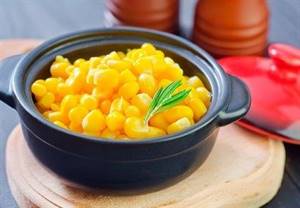
- canned food;
- popcorn;
- porridge;
- steamed.
You can also include a decoction of corn silk in this list. It contains the largest number of useful components.
It is not difficult to prepare a decoction. It is done in a water bath. To prepare the decoction you will need to take 2 tbsp. dried stigmas, put them in a small enamel pan, and then pour in 250 ml of boiled water. After this, you will need to cover the container with a lid and wait about 20 minutes.
Then it remains to strain the liquid and let it cool. You can use this remedy after meals, 1 tbsp. every 4-6 hours. The point of using the decoction is that it contains the maximum amount of useful substances.
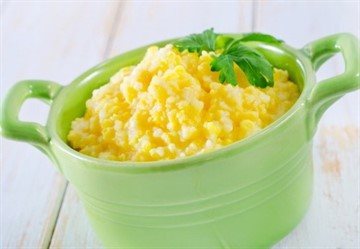
A dish that must be included in a diabetic’s diet is corn porridge.
It is best to cook it in water according to the instructions on the package. This product is very easy to make.
It contains a large amount of useful substances and at the same time almost does not increase the rate of increase in plasma glucose.
Patients with diabetes are allowed to eat canned corn, but it is not recommended to abuse it. Therefore, it is not suitable for a side dish, but it can be used as one of the salad ingredients.
Boiled corn has a fairly high GI, so it should be consumed in moderation. But at the same time, it is advisable to include it in the diet, since it contains a very large amount of vitamins and minerals. At the same time, it is better not to boil corn in water, but to steam this cereal. This way it will retain almost all its properties.
Additional features
Barley and cereals prepared on its basis are actively used in the field of traditional medicine.
This is explained, for example, by the fact that a decoction based on them is characterized not only by a softening or enveloping effect, but also by antispasmodic and anti-inflammatory effects. We should not forget about the general strengthening properties, which will be useful for anyone who has been diagnosed with type 1 or type 2 diabetes. Barley is also used in the treatment of this disease because it makes it possible to combat impaired vision, kidney, liver or gall bladder diseases. The presented product will be no less useful if it is necessary to restore the optimal condition of the urinary tract and for ailments of the entire gastrointestinal tract system.
In addition, it is barley porridge and all the components contained in it that significantly alleviate the pain of arthritis, including the rheumatic type.
A decoction prepared from barley is characterized by various positive effects on the general condition of the body. In addition, it is with the help of barley that it is possible to treat pathological conditions associated with the mammary gland, as well as get rid of constipation or obesity. If the body is in normal condition, treatment of coughs and colds is possible.
DIABETES IS NOT A VERDICT! Myasnikov told the whole truth about diabetes! Diabetes will go away forever in 10 days if you drink in the morning... »read more >>>
I would also like to draw attention to the fact that the presented diabetic product can also be used as a general tonic. This is carried out in the period after surgery for inflammatory diseases of the stomach or intestines. Thus, eating barley in the form of porridge and other food products is more than acceptable. However, it is strongly recommended to first consult with a specialist and familiarize yourself with the list of main contraindications and restrictions.
ul
Interpretation of indicator results
If the indicator value is less than 40 points, then the glycemic index is low, 40-70 points is average, and above 70 is high. Patients who lead a healthy lifestyle or follow a diabetic diet should plan their diet taking into account the glycemic index of foods.
After eating high GI cereals, your blood sugar levels rise sharply. There is an intense production of the hormone insulin, which performs the following functions:
- reducing the concentration of sugar in the blood by distributing it to different tissues of the body (short-term use or for reserve);
- reconversion of fats into glucose.
Cereals with low GI linger for a long time in the intestines and stomach. They break down slowly, preventing a sharp rise in blood sugar levels. This ensures a long-lasting feeling of satiety. Nutritionists recommend choosing foods with a low GI value for weight loss.
The glycemic index of rice ranges from 45-60 units. Rice porridge is indicated for dietary nutrition. Its main advantage is low cholesterol and glucose levels. Brown unpolished rice is quickly absorbed by the body. Its husk contains many useful substances:
- vitamins;
- amino acids;
- nutritional proteins;
- antioxidants.
Buckwheat is rich in iron, calcium, magnesium, zinc and iodine. Its glycemic index is 50-60 units. Buckwheat porridge is included in the diet of diabetics, as it controls blood sugar and cholesterol levels. Buckwheat with a low glycemic index is included in the diet during the diet (for weight loss).
ul
What is glycemic load?
Glycemic load (GL) is a comparison of the quality of carbohydrates (that is, their glycemic index) and their quantity in different foods.
GN does not measure how quickly food turns into sugar. It reflects how much a particular food product contains of substances that can turn into sugar in principle.
Just like GI, glycemic load shows how much a particular food increases blood sugar levels and triggers the release of insulin.
The lower the GN of a product, the slower the amount of glucose increases after its consumption, and the less insulin is synthesized. As a result, blood sugar levels are more stable and hypoglycemia does not develop.
Based on the glycemic load, all food products are divided into three categories:
- with high GN – 20 and above;
- with average – 11-19;
- from low – up to 10 inclusive.



